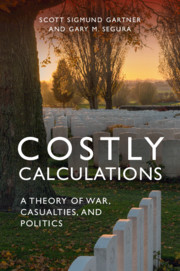Book contents
- Costly Calculations
- Costly Calculations
- Copyright page
- Dedication
- Contents
- Figures
- Tables
- Acknowledgments
- 1 Introduction
- 2 A Price Theory of War
- 3 Calculating War’s Price: What’s It Worth, and How Much Will It Cost?
- 4 The Price Theory of War in Action: Experimental Demonstrations of the Impacts of Expected Costs and Valuable War Aims
- 5 Conflict Dynamics across Space and Time: Public Opinion in the Korean and Vietnam Wars
- 6 Getting Wartime Information from Over-There to Over-Here: News Media and Social Networks
- 7 Elite Opinion Formation and Its Electoral Consequences
- 8 Conclusion: Wars, Casualties, Politics, and Policies
- Bibliography
- Index
2 - A Price Theory of War
Published online by Cambridge University Press: 18 June 2021
- Costly Calculations
- Costly Calculations
- Copyright page
- Dedication
- Contents
- Figures
- Tables
- Acknowledgments
- 1 Introduction
- 2 A Price Theory of War
- 3 Calculating War’s Price: What’s It Worth, and How Much Will It Cost?
- 4 The Price Theory of War in Action: Experimental Demonstrations of the Impacts of Expected Costs and Valuable War Aims
- 5 Conflict Dynamics across Space and Time: Public Opinion in the Korean and Vietnam Wars
- 6 Getting Wartime Information from Over-There to Over-Here: News Media and Social Networks
- 7 Elite Opinion Formation and Its Electoral Consequences
- 8 Conclusion: Wars, Casualties, Politics, and Policies
- Bibliography
- Index
Summary
The Reservation Point — RP — captures the value of achieving a set of war aims and Expected Total Costs — ETC — captures a war’s anticipated costs. Both vary across persons and conflicts and together determine the relationship between military casualties and opinion. Not achieving the aims makes costs unacceptable, endogenizing winning and losing. Variations in casualty expectations over time and space lead the political consequences of war to differ temporally and geographically. The role of casualties grows over the duration of the conflict. Marginal casualties will have a proportionally greater effect on the population’s estimates of total expected casualties (ETC) at the start and cumulative casualties over the duration of a conflict. Individuals’ values of wars and their aims fluctuate, which means that opposition will be triggered at different levels of expected and observed costs. The distribution of beliefs about the value of a conflict’s war aims and the distribution of ETC — both of which may change within a specific conflict, and clearly vary across them — are the primary (although not unique) factors that shape elite and mass approval.
Keywords
- Type
- Chapter
- Information
- Costly CalculationsA Theory of War, Casualties, and Politics, pp. 39 - 68Publisher: Cambridge University PressPrint publication year: 2021

